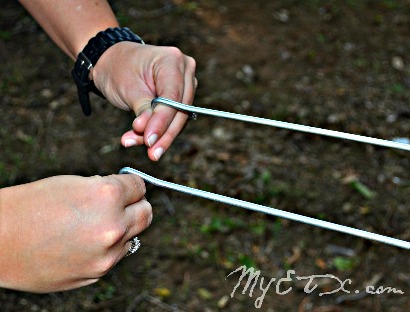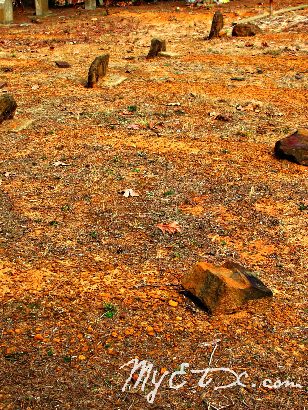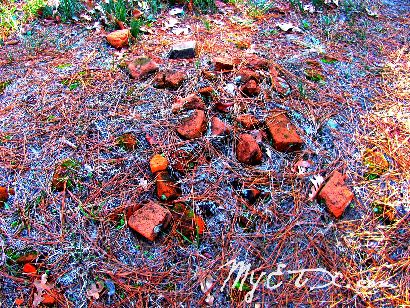|
Some
call it science others call it supernatural. Call it what you will,
but dowsing has proven to be an effective method that has been used
for centuries to find underground objects of interest. The art of
dowsing can be traced back to the days of cave men through cave paintings
and was officially documented during the middle ages. Not everyone
believes in the ancient technique and some say even say it is tied
to witchcraft. Modern day dowsers use the technique to find lost graves,
water, archeological sites, buried treasures, coal and oil. Dowsing
and witching in East Texas
could turn up anything from pioneers to buried treasure!
Have you ever walked around in one of the many historical
cemeteries of East Texas?
Some historical cemeteries in the region are marked by historical
markers and magnificent hundred-year-old head stones all of which
tell the stories of those resting under the earth. But perhaps you
have wandered about the grounds of less kept cemeteries or speculated
burial grounds and saw iron rock mounds, wooden stakes, large slabs,
bricks or you may have seen an area speckled with sink holes and wandered
who or what lies beneath. |
 |
| East Texans have
been using the dowsing technique since the pioneer days. There are
various ways dowsing is performed. The most common way dowsing is
performed is with two bent rods of metal. Some prefer copper or brass
because they are not affected by electromagnetism, while others prefer
iron, steel, or tin, because they are affected by electromagnetism.
Others use whatever is on hand, such as coat hanger. Some people prefer
metal shaped like a “Y,” with the point sticking forward. Some prefer
willow wood, some prefer witch hazel, and others insist on using peach
tree limbs. |
 |
The
art of dowsing for lost graves takes practice. Each dowser must develop
his or her own technique. The easiest way to learn to dowse is to
practice on a marked grave. By practicing dowsing in a marked cemetery
you will perfect your technique and be ready to go out on an adventure.
There are several ways to make your own dowsing rods. Metal coat hangers
make great dowsing rods. Grab two metal coat hangers out of your closet
and cut the coat hangers at the neck, just before the point where
they join to form the hook of the coat hanger.
Straighten each hanger as much as possible. The hangers should measure
approximately 36 inches. Make a handle at one end of the hanger by
bending the wire hanger in an L-shape at a 90 degree angle. The handle
size should vary to fit each individuals hand, roughly four and six
inches long. Some people make sleeves for the handles of their dowsing
rods in order to allow the rods to move freely without obstruction.
Dowsing takes patience and is a tricky technique to master. Serious
dowsers know that even a breeze can affect the outcome of a dowsing
endeavor. Seasoned dowsers recommend using heavier dowsing rods if
the wind is blowing, but dowsing is best when there is little to no
wind. |
 |
|
Now
that you have made your dowsing rods, let’s get witching.
Hold the Dowsing L-shaped rods in each hand with the long portion
protruding in front of you with your elbows at a 90 degree angle.
Be sure your forearms are straight out in front of you. Now, hold
your arms close to your body. Both arms and the rods should be parallel
to the ground.
Approach the suspect gravesite slowly and remain steady. If there
is a body is present, the two rod tips will begin to swing inward
and will cross in front of you when you are over the grave. As soon
as you step off the grave, the rods will uncross.
Once
you have determined the whereabouts of the suspect gravesite, back
up and re-approach the body near the point you believe to be the
feet.
How do you know which end is the foot of the grave? Most cemeteries
in the United States are laid out in the Christian burial manner,
meaning most bodies are laid with their head pointing West and their
feet pointing East. (Remember, it wasn’t that long ago, only a couple
of hundred years, that Indians roamed the Pineywoods. Indian burials
took place in various ways, including the “sitting position.”) It
is important to find the feet if you want to determine the gender
and age of the person resting below.
Have
you found the body of a man or woman? One of the most popular methods
of determining the gender of your find is the “One-Finger” method.
Stand in the middle of the suspected grave site. Balance the handle
of one of your dowsing rods on your index finger, holding the rod
straight down. The rod will then begin to move in a circular motion.
If the rod rotates counterclockwise then you have found a male body
and if the rod rotates clockwise you have found a female body. This
method is believed to be effective even if the body has been buried
“backwards,” or if two bodies have been buried in one grave or coffin.
If
you want to try your hand at determining the approximate age of
the body in the grave, begin at the foot and walk the length of
the grave, counting the number of steps taken. The rods will cross
at the foot of the grave and remain crossed until you step off the
site, over the body.
Typically, one to two steps indicate you have found the body of
an infant, two to three steps indicate a toddler body, three to
four steps indicate a child’s body, five steps could be an adolescent
body or small adult, six steps is believed to be an adult body and
seven steps indicates a very tall adult. These results may vary
according to each individual however these measurements are a good
guide to follow.
What
exactly causes dowsing rods to cross? Some scientists suggest the
rods are picking up a disturbance in the earth’s magnetic field
while others claim the rods are picking up the gases from decaying
bodies. Still, others say it has something to do with the magnetic
field a body gives off even after death.
Some East Texans believe dowsing is a “gift,” others say it takes
lots and lots of practice. Researchers say 90 percent of people
are capable of dowsing. Don’t get discouraged if you are not immediately
successful.
Water
dowsing is performed almost the same as basic grave dowsing, however,
there is a slight difference in the reaction of the rods when you
find a body of water underground. While dowsing, if you walk over
a well or body of water underground, your rods will lead you in
one direction and around in a circular motion. However, water pipes
will cause your rods to cross.
How do you know if you have found a human body or a body of water
beneath the earth? This is where practice comes in. Most of the
time the rods will stay crossed as long as you remain over either
type of body.
Some people have associated dowsing with witchcraft and voodoo,
others use the technique as a last resort. Some say it just an old
wives’ tale but these days dowsing is used by archeologists and
geologists. Some companies even have dowsers on their payroll.
East Texas holds some
of the oldest history in the state and is an excellent area to try
out your dowsing skills. If you are interested in looking for the
lost or forgotten and maybe even some buried treasure, try your
hand at the ancient technique of dowsing in the Pineywoods!
© Dana Goolsby
"In The Pines With Dana Goolsby"
October 16, 2011 Column
More Stories
on Dowsing ›
|
Forum:
Subject: Dowsing
As a dowser myself, I appreciate the article on dowsing. I use copper
wire, AKA 'Spanish rods.' You can spend a week's pay to buy a set
out of an ad in a treasure-hunting mag, or you can do what I do. I
buy 2 3-ft lengths of fairly heavy copper wire & strip the insulation.
There is nothing 'magical' or 'supernatural' about dowsing. It is
simply a natural force we don't yet understand. I have found that
there must be physical contact between the body & the rods. When I
hold them in my hands they work. If I put them in copper, brass, or
aluminum tubes, then hold the tubes in my hands, they work. However,
if I put them in plastic or glass tubing & hold the tubing with no
physical contact with my hands, they don't work.
Several years ago the late Dr. I. Waynne Cox, an archaeologist at
UTSA, was given the task of doing salvage archaeology on the old Joske's
parking lot in downtown San Antonio. It was originally a German neighborhood,
which was razed to build the parking lot. A new mall was to be constructed
atop the old parking lot. Dr. Cox recruited me to dowse for him.
The lot had previously been worked with a metal detector & the locations
of the detector strikes marked w/orange paint. My rods picked up the
detector strikes--& also picked up an underground void. When the rods
find a void they spread apart, pointing down the axis of the void.
A house the team was particularly interested in wasn't where the Sanborn's
map said it should be. I located it some 10 feet from the Sanborn's
location. I also located, at a back corner, a circular feature not
on the Sanborn's map. It turned out to be a stone-lined, ground-level
cistern filled with 19th & early 20th century trash--a gold mine for
the archaeologists. Had the house been where it was supposed to be
the archaeologists would have located the front corners of the foundation
& excavated the basement, but since the cistern was not on the map
they would have had no way of knowing it was there & it would not
have been excavated. Only because I found it with my rods was it excavated.
Its contents turned out to be very important to the dig.
- C. F. Eckhardt,
October 17, 2011 |
More on Dowsing:
The
Ancient Art of Dowsing by C. F. Eckhardt
In the search for water, minerals, and many other things, there
is nothing quite as controversial as the practice of dowsing, whether
it be with a forked willow or peach switch, the 'Spanish rods,'
or any number of other devices. There are two things you can say
for certain about dowsing... more
The
Wonderful Boy by Mike Cox
His father a respected Uvalde County rancher, the quiet, good-looking
Guy O. Fenley seemed like a typical teenager except for one thing
– he could see underground water.... more
Water
producers, grandmas make miracles by Delbert Trew
Of all the strange, weird and confusing bits of history, none quite
compare with rain dancers, water witchers and grandmas. Each could
perform miracles if the sign was right, a fresh peach tree twig
was used or the malady could be cured with Castor Oil or Black Draught
Tonic... more
Related Topic:
About ghosts, spirits, superstitions...
|
|
|
